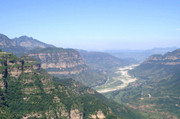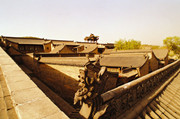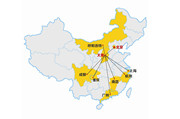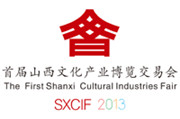Shanxi Mural
By Ding Yujie ( Chinaculture.org )
Updated: 2012-08-02
Mural painting is like an inexhaustible encyclopedia, and Shanxi Province boasts the most abundant mural paintings in China, second only to the Dunhuang Mural in Gansu Province. Shanxi has mural paintings that could date back to the Eastern Han Dynasty (25-220). The following dynasties from the Northern Dynasty (220-580) to the Qing Dynasty (1644-1911) also witnessed the style's development. The styles of Shanxi murals in different phases not only embody the painting characteristics of various periods, but also have a certain value for artistic, social and religious research.
 |
|
Shanxi Mural |
Development of Shanxi Mural
Most of the Han murals were painted on the walls of tombs, and deal with the prevailing custom of filial piety and buryialwith full honors, which the ruling class eagerly promoted. Many aristocrats’ graves are of considerable size, reflecting the political, economic and institutional systems that time. The Pinglu mural in Shanxi is representative of Han murals. The Northern Dynasty preserved the custom of tomb mural painting. With the development of communications and the rise of Buddhism, the themes of the mural paintings at this time were more or less related to Buddhism. The artist of the Lourui Tomb in Shanxi was also affected in this way.
The Yuan Dynasty (1279-1368) had the vastest territory in Chinese history. Known as the "belly" of the Yuan Dynasty, Shanxi has a number of exquisite Yuan temple murals of about 1800 m2. Murals of Yongle Palace in Ruicheng City, Shanxi Province, are the essence of Yuan temple murals.
 |
|
Shanxi Mural in Ming Dynasty |
In the days after the Ming Dynasty, mural paintings were rarely recorded in books. Temple murals had already come to an end. However, Shanxi murals still preserve some excellent works, such as Jiyi Temple in Xinjiang County and Goddess Temple in Fenyang County.
Varieties of Shanxi Mural
Tomb mural: Shanxi has retained tomb murals from three different periods: Han, Northern and Yuan Dynasties. The tomb murals of Pinglu in Zaoyuan Village are an important representative of the Eastern Han dynasty tomb murals. The Lou Rui Tomb is a tomb of the Northern Dynasty, whose accurate-composed murals are of vivid image, beautiful color and smooth lines, which show the complicated art technique of that time. The mural paintings in Zhang Daozhen Tomb are completely different from the others of previous years. The master of this Yuan tomb was a Taoist, so the murals are a reflection of his life, taste and preferences.
 |
|
Tomb Mural in Lou Rui Tomb |
Temple mural: Among the existing murals in Shanxi, there are the most temple murals. Fo Guang Temple in Wutai Mountain has the only temple mural of the Tang Dynasty. Although with some image defects due to its old age, the superb artistic technique and well-preserved condition still make it a top grade Chinese ancient temple mural.
 |
|
Temple Mural |
Grotto mural: The Yungang Grottoes in Datong Shanxi have a lot of mural relics. They are regarded as “Precious Grotto,” with the other three famous grottoes: Mogao Grottoes in Dunhuang, Longmen Grottoes in Luoyang, and Maiji Mountain Grottoes in Tianshui, Ganshui. They are also Chinese mural museums.
Themes of Shanxi Mural
Religion: Religion is an important topic for the whole of Chinese mural, and Shanxi mural is no exception. The period of Emperor Hanwu (140-86 BC) saw the beginning of Taoist murals, while the Eastern Han witnessed the rise of Buddhist mural. The mural in Yongle Palace is a classic example of Taoist murals. Legends and historical figures: Legends and historical figures were the theme of temple murals during the Ming and Qing Dynasties. The Jiyi Temple of the Ming Dynasty is a typical example. It mainly focuses on the legends of ancient time, such as the performances of legend heroes Dayu, Houji and Boyi.




